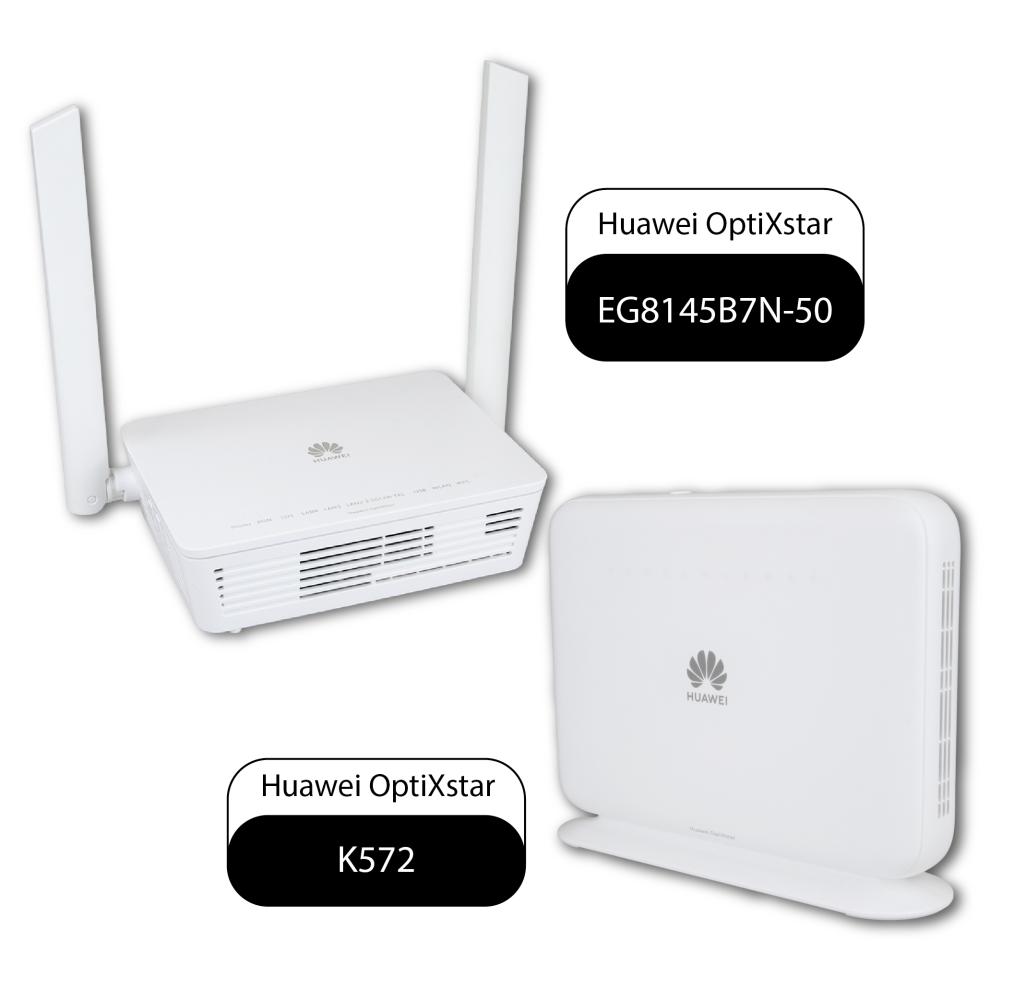-
Kč

Huawei EG8145B7N-50
The Huawei OptiXstar EG8145B7N-50 is a client terminal ONT designed for GPON networks. It features an SC/APC optical connector with a Class B+ laser, and the receiver sensitivity is -27 dBm. The terminal supports Wi-Fi 7 wireless transmission, using IEEE 802.11 b/g/n/ax/be protocols in the 2.4 GHz band and IEEE 802.11 a/n/ac/ax/be in the 5 GHz band. The maximum theoretical Wi-Fi throughput is 688 Mb/s in 2.4 GHz and 2882 Mb/s in 5 GHz. The terminal provides higher wireless network speeds compared to standard Wi-Fi 6 solutions with 2x2 MIMO.
The device is equipped with 1 2.5G Ethernet port (10/100/1000/2500 Mb/s) and 3 1G Ethernet ports (10/100/1000 Mb/s). The use of the 2.5G port allows for full utilization of the bandwidth offered by the GPON standard (2.5/1.25 Gb/s). Additionally, the terminal has 1 POTS port for connecting an analog phone and a USB 2.0 port. The manufacturer has used external omnidirectional antennas with a 5 dBi gain, providing better transmission range than devices with integrated antennas.
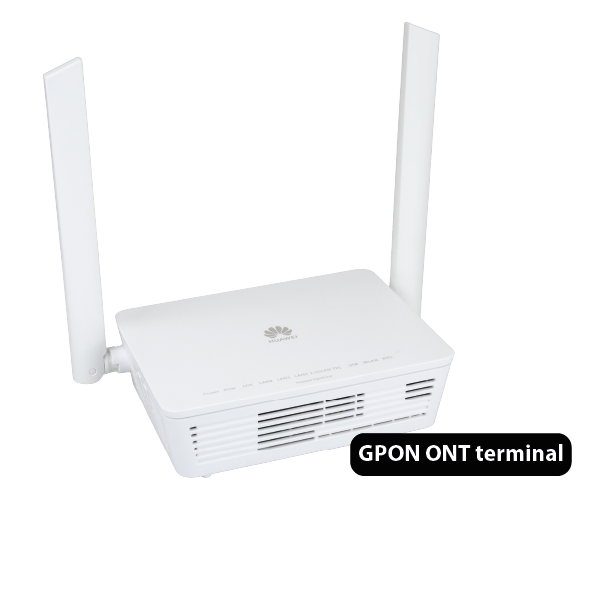
GPON ONT terminal
The offered product is designed to function as a client terminal ONT in GPON networks. It is equipped with an SC/APC optical port with a Class B+ laser. The receiver sensitivity is -27 dBm.
According to the GPON standard, the transmission bandwidth is 2.5 Gb/s for data download and 1.25 Gb/s for data upload.
Wi-Fi 7 BE3600
The device can transmit a Wi-Fi 7 network, supporting IEEE 802.11 b/g/n/ax/be protocols in the 2.4 GHz band and IEEE 802.11 a/n/ac/ax/be in the 5 GHz band. The maximum theoretical throughput is 688 Mb/s in 2.4 GHz and 2882 Mb/s in 5 GHz. This speed is sufficient for most subscribers, providing a high level of comfort when using internet resources.
Wi-Fi 7, in addition to features known from earlier generations, introduces two important innovations: Multi-RU and MLO. Multi-RU allows for the allocation of more than one resource unit (RU) to a single user, optimizing the network. This eliminates situations where a resource unit is not allocated to any user. MLO (Multi-Link Operation) enables devices to simultaneously transmit and receive data over multiple bands (in this case, 2.4 and 5 GHz). This significantly improves throughput compared to older Wi-Fi 6 / Wi-Fi 6E standards, where the client was connected to only one band at a time.
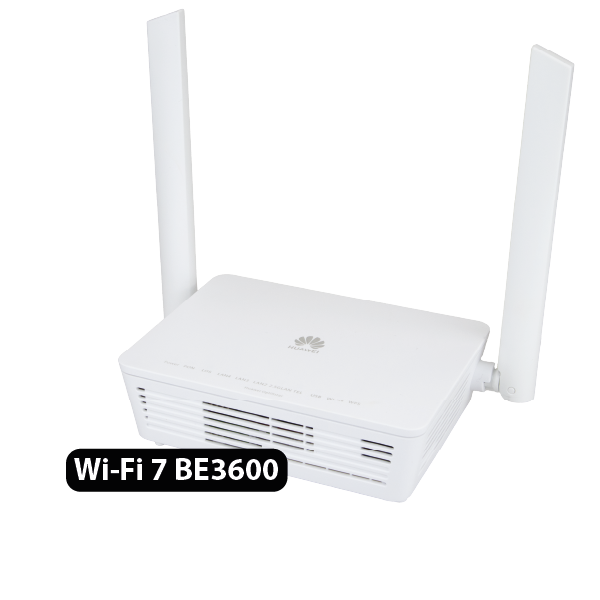
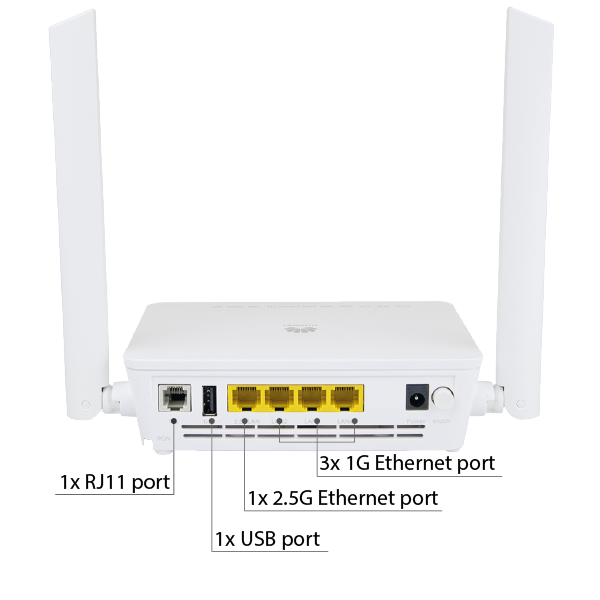
1x 2.5G Ethernet port, 3x 1G Ethernet port, 1x RJ11 port, 1x USB port
One of the key advantages of the EG8145B7N-50 is the inclusion of the 2.5G Ethernet port, which allows you to fully utilize the capabilities of GPON technology. Without changing the network infrastructure to XG-PON / XGS-PON, you can offer your subscribers packages with speeds over 1 Gb/s. The remaining three ports support the standard bandwidth of 1 Gb/s.
Additionally, the device is equipped with an RJ11 telephone port (POTS), which is useful if you offer VoIP services. The USB port enables users to, among other things, create a file server or share printers.
An ideal client device for GPON networks
With its modern Wi-Fi generation and the inclusion of a 2.5G Ethernet port, the EG8145B7N-50 is perfect as the main client terminal in your network. It allows you to offer subscribers triple play packages with internet speeds greater than 1 Gb/s. The device uses GPON technology, so you don't need to change your network infrastructure to stay a step ahead of the competition.
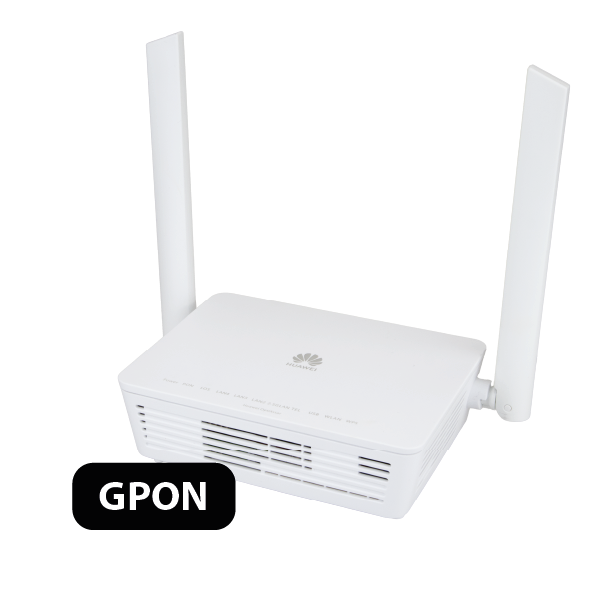
Huawei K572
Huawei OptiXstar K572 is a wireless router that supports Wi-Fi 7. It uses IEEE 802.11 b/g/n/ax/be protocols in the 2.4 GHz band and IEEE 802.11 a/n/ac/ax/be in the 5 GHz band. The maximum theoretical transmission throughput is 688 Mbps on 2.4 GHz (2x2 MIMO) and 2882 Mbps on 5 GHz (2x2 MIMO). This is a higher speed than what standard Wi-Fi 6 solutions with 2x2 MIMO offer. The main advantage of the K572 is its two 2.5G Ethernet ports (10/100/1000/2500 Mbps), one of which serves as a WAN port and the other as a LAN port. This allows you to offer subscribers 2.5 Gbps packages and provide them with equipment capable of handling such throughput. Additionally, the router has two more gigabit Ethernet LAN ports (10/100/1000 Mbps).
The offered product supports the Mesh function – together with other compatible devices, it can create a unified, extensive wireless network. Individual devices within this network can communicate with each other wirelessly, without the need for Ethernet cabling. Pairing is very simple and can be done using a button. The K572 supports automatic Wi-Fi configuration synchronization and wireless channel usage optimization. Additionally, the router supports Wi-Fi roaming – IEEE 802.11k/v protocols. The device is best suited for subscribers who have large houses or apartments. It can be installed together with an ONT terminal to ensure adequate wireless network coverage.
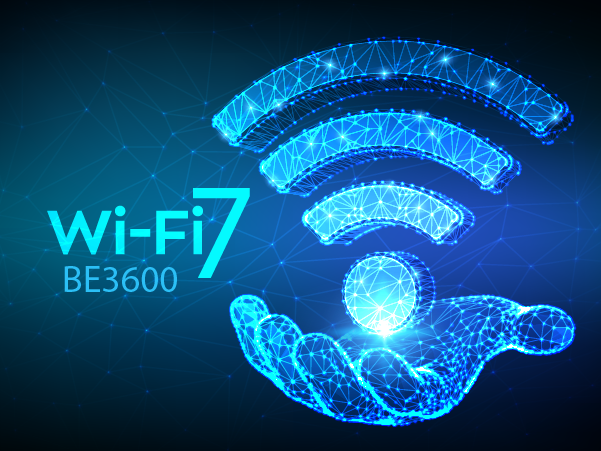
Wi-Fi 7 BE3600
The device can transmit a wireless network using the Wi-Fi 7 standard. It utilizes IEEE 802.11 b/g/n/ax/be protocols in the 2.4 GHz band and IEEE 802.11 a/n/ac/ax/be in the 5 GHz band. The maximum theoretical throughput is 688 Mbps on 2.4 GHz and 2882 Mbps on 5 GHz.
Wi-Fi 7 is not only about higher network speeds but also introduces other useful features. The most important of these is MLO – Multi-Link Operation. It allows a connection to be established across more than one frequency band simultaneously, whereas in previous Wi-Fi generations, users could only connect to the router in one specific band. Multi-RU enables the allocation of non-contiguous portions of the channel to users, which translates to significantly better utilization of available frequency spectrum.
Integrated Omnidirectional Antennas
Inside the housing are four integrated omnidirectional antennas. Their gain is 4 dBi in the 2.4 GHz band and 5 dBi in the 5 GHz band. Combined with the Beamforming function, they provide a high and reliable level of wireless coverage.

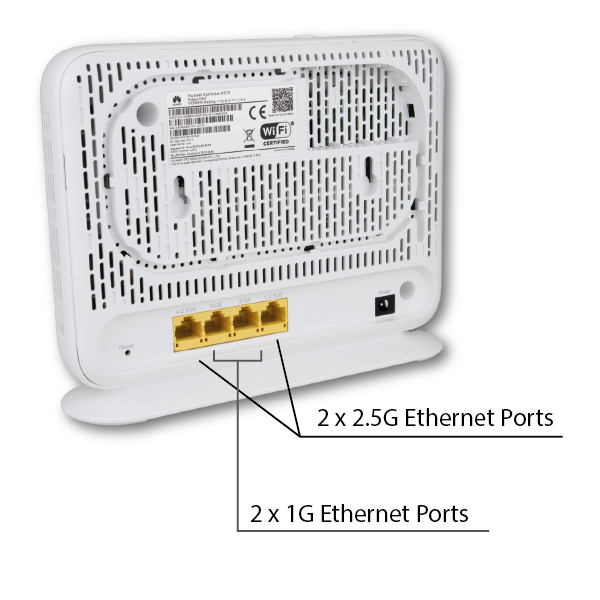
2 x 2.5G Ethernet Ports, 2 x 1G Ethernet Ports
The router is equipped with 2 x 2.5G Ethernet ports and 2 x 1G Ethernet ports, including 1 WAN port (2.5G Ethernet) and 3 LAN ports. All ports support automatic link speed negotiation — even the 2.5GE ports can operate in 10 / 100 Mbps modes. If you're using a wireless WAN connection, all Ethernet ports function as LAN ports. The K572 automatically detects the type of connection without the need to manually switch between WAN and LAN modes.
Mesh Network
The offered product can operate in a Mesh network with a tree topology. If you're using a Huawei ONT terminal at home, you can wirelessly connect the K572 to it via the WPS button. This allows the creation of a large-scale wireless network that will appear under a single name to the user. The router supports Wi-Fi roaming (802.11k/v standards) and automatic synchronization of Wi-Fi configuration.


Application
The Huawei H572 is best used in combination with a Huawei ONT terminal to extend an existing wireless network and increase its coverage. The 2.5G Ethernet ports provide very high wired connection throughput, while Wi-Fi 7 offers the highest currently available standard for wireless connectivity. Due to all these advantages, the offered product is also an excellent solution for use as a standalone router.
Specifications
| Huawei EG8145B7N-50 | |
| Device Parameters | |
|---|---|
| Dimensions (H x W x D) | 40 mm x 150 mm x 108 mm (without external antenna and pads) |
| Weight | About 282 g |
| Operating temperature | 0°C to 40°C |
| Operating humidity | 5% RH to 95% RH (noncondensing) |
| System power supply | 12 V DC, 1,5 A |
| Power adapter input | 100 - 240 V AC, 50/60Hz |
| Memory |
128 MB Flash 256 MB RAM |
| Static power consumption | 5 W |
| Maximum power consumption |
14 W |
| NNI (WAN) | GPON |
| UNI (LAN) | 1x 2.5GE, 3x GE, 1x POTS, 1x USB, Wi-Fi 7 |
| Optical connector | SC/APC |
| Indicators | Power / PON / LOS / LAN1 / LAN2 / LAN3 / 2.5GLAN / TEL / USB / WLAN / WPS |
| Interface Parameters | |
| GPON port | Class B+ Receiver sensitivity: -27 dBm Overload optical power: -8 dBm Wavelengths: US 1310 nm, DS 1490 nm Wavelength blocking filter (WBF) of G.984.5 Flexible mapping between GEM Port and TCONT GPON: consistent with the SN or password authentication defined in G.984.3 Bi-directional FEC SR-DBA and NSR-DBA |
| WLAN | IEEE 802.11 b/g/n/ax/be (2.4GHz) IEEE 802.11 a/n/ac/ax/be (5GHz) 2×2 MIMO (2.4GHz&5GHz) Antenna gain: 5 dBi Air interface rate: 688 Mbit/s (2.4GHz), 2882 Mbit/s (5GHz) 4096 QAM 160 MHz frequency bandwidth OFDMA MU-MIMO DCM BSS Coloring Beamforming Band steering WPA3 MLO (Multi-Link Operation) Multi-RU WMM/Multiple SSIDs/WPS |
| POTS port | Maximum ringer equivalence number (REN): 4 G.711A/μ, G.729a/b and G.722 encoding/decoding T.30/T.38/G.711 fax mode DTMF Emergency calls (with the SIP protocol) |
| USB port | USB2.0 FTP-based network storage File/Print sharing based on SAMBA DLNA function |
| Ethernet port | 1x2.5GE+3xGE Ethernet port-based VLAN tags and tag removal 1:1 VLAN, N:1 VLAN, or VLAN transparent transmission QinQ VLAN Limit on the number of learned MAC addresses MAC address learning GE port supports auto-adaptive 10 Mbit/s, 100 Mbit/s or 1000 Mbit/s 2.5GE port supports auto-adaptive 10 Mbit/s, 100 Mbit/s, 1000 Mbit/s or 2500 Mbit/s |
| Product Function | |
| Smart interconnection | Smart Wi-Fi coverage SIP/H.248 auto-negotiation Any port any service Parental control |
| Smart service | Scheduled Wi-Fi shutdown Smart Wi-Fi sharing: Portal/802.1x authentication; SoftGRE-based sharing |
| Smart O&M | IPTV video quality diagnosis Rogue ONT detection and isolation from the OLT Call emulation, and circuit test and loop-line test PPPoE/DHCP simulation testing Neighboring AP scanning |
| Layer 3 features | PPPoE/Static IP/DHCP NAT/NAPT Port forwarding ALG, UPnP DDNS/DNS server/DNS client IPv6/IPv4 dual stack, DS-Lite and IPv6 SPI Static/Default routes Multiple services on one WAN port |
| Multicast | IGMP v2/v3 snooping IGMP v2/v3 proxy MLD v1/v2 snooping |
| Security | SPI firewall Filtering based on MAC/IP/URL addresses Secure boot |
| Q&M | OMCI/Web UI/TR069 Variable-length OMCI messages Dual-system software backup and rollback |
| QoS | Ethernet port rate limitation 802.1p priority SP/WRR/SP+WRR Broadcast packet rate limitation |
| Home network feature | Visualized home network management User-defined bandwidth allocation Wi-Fi optimization & Wi-Fi roaming Wi-Fi O&M |
| Huawei K572 | |
| Physical | |
|---|---|
| Dimensions (H x W x D) | 140 mm × 188 mm × 35 mm (excluding the base) |
| System power supply | 12 V DC, 1 A |
| Rated Power Input for Power Adapter | 100 - 240 V AC, 50/60 Hz |
| Max power consumption | < 12 W |
| Indicator | 1 status indicators |
| Buttons |
Reset button WLAN/WPS button |
| Memory | 128 MB Flash, 256 MB RAM |
| Installation mode | Vertically placed on a desk or mounted on a wall |
| Operating temperature | 0°C to 40°C |
| Operating humidity | 5% RH to 95% RH (noncondensing) |
| Interface |
NNI (WAN): 2.5G Ethernet or Wi-Fi UNI (LAN):
|
| Wi-Fi | |
| Supported Protocol |
Wi-Fi 7
2,4 GHz: IEEE 802.11 b/g/n/ax/be 5 GHz: IEEE 802.11 a/n/ac/ax/be |
| Antenna gain |
2,4 GHz: 4 dBI 5 GHz: 5 dBi |
| MIMO | 2×2 MIMO (2.4GHz&5GHz) |
| Air interface rate |
2,4 GHz: 688 Mb/s 5 GHz: 2882 Mb/s |
| Others |
WMM(Wi-Fi Multimedia) Beamforming Band steering 4096 QAM 160 MHz channel width WPA3 MU MIMO MLO (Multi-Link Operation) Multi-RU |
| Interface | |
| Ethernet port |
Limit on the number of learned MAC addresses MAC address learning GE port supports auto-adaptive 10 Mbit/s, 100 Mbit/s or 1000 Mbit/s 2.5GE port supports auto-adaptive 10 Mbit/s, 100 Mbit/s, 1000 Mbit/s or 2500 Mbit/s |
| Feature | |
|
Home Network |
Working with gateway supports the following features:
|
| Home Network Management | Working with the iMaster NCE platform supports remote management and maintenance |
| Smart Interconnection |
2 upstream modes: Ethernet upstream mode and Wi-Fi upstream mode
be connected to the iMaster NCE platform)
2-level cascading networking) |
| Layer 3 Features |
PPPoE/static IP/DHCP NAT/NAPT Port forwarding ALG, UPnP DDNS/DNS server/DNS client IPv6/IPv4 dual stack Static/default routes |
| O&M | Web UI Dual-system software backup and rollback |
| Security |
SPI firewall Parent control |






 Polski
Polski English
English Italiano
Italiano Español
Español Čeština
Čeština Српски
Српски Deutsch
Deutsch Ελληνικά
Ελληνικά Slovenský
Slovenský

